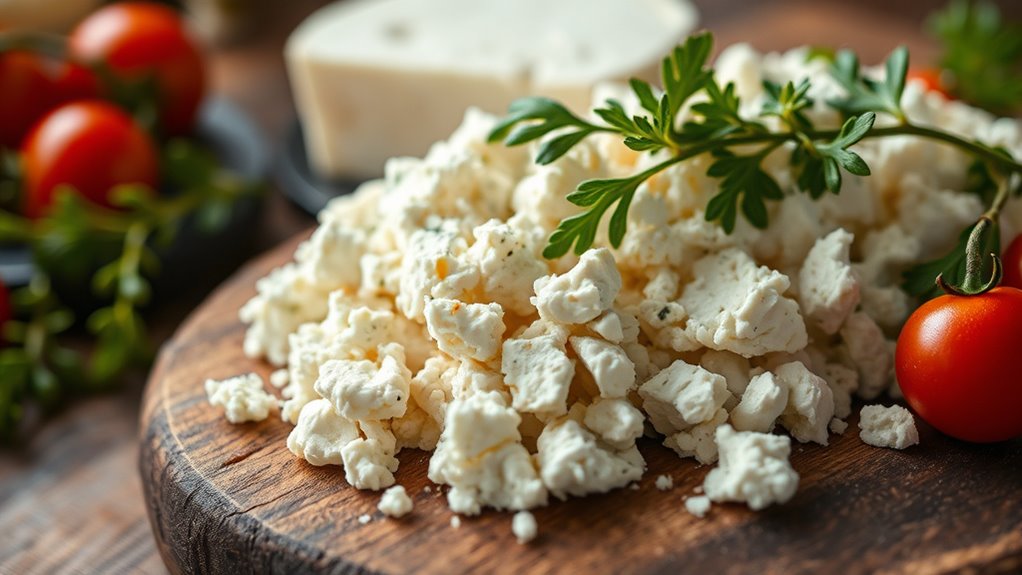Using precision fermentation, you can create a homemade vegan feta that closely mimics traditional cheese in flavor and texture. This process involves fermenting plant-based ingredients like cashews or soy with specific bacterial cultures to develop tanginess and a crumbly consistency. By controlling fermentation time and conditions, you can fine-tune the taste and texture of your cheese. Want to discover step-by-step tips and tricks for perfect homemade vegan feta? Keep exploring for all the details.
Key Takeaways
- Precision fermentation uses specific cultures to produce dairy-like flavors in plant-based cheese, creating authentic vegan feta.
- It involves fermenting plant proteins with targeted bacteria or molds to develop tangy, cheese-like characteristics.
- Homemade vegan feta can be made by inoculating plant-based dairy with fermentation cultures and allowing controlled fermentation.
- This method offers customizable flavor profiles and textures, closely mimicking traditional feta’s crumbly, tangy qualities.
- Using precision fermentation reduces reliance on animal products, promoting sustainable and eco-friendly cheese alternatives.

If you’re craving the tangy, crumbly flavor of feta cheese but want a plant-based option, vegan feta alternatives offer a delicious solution. The key to creating a convincing vegan feta lies in harnessing the power of plant-based dairy and fermentation techniques. Unlike traditional dairy-based feta, which relies on milk fermentation, these plant-based approaches replicate the complex flavor and texture through innovative fermentation processes. By fermenting plant proteins and fats, you can develop the signature tanginess and crumbly consistency that make feta so appealing, all without animal products.
Vegan feta mimics traditional flavor through plant-based fermentation, delivering tangy, crumbly cheese without animal ingredients.
In making a homemade vegan feta, you start with plant-based dairy ingredients like cashews, almonds, or soy to serve as the base. These ingredients are rich in fats and proteins, providing the foundation needed to mimic dairy cheese. The magic happens when you introduce fermentation techniques—using specific strains of bacteria or molds—to transform these neutral-tasting plant foods into a tangy, cheese-like product. You might add probiotic cultures, which ferment the sugars present in the plant base, producing lactic acid and developing that characteristic sharpness. This fermentation process not only imparts flavor but also enhances digestibility and nutrient availability.
The process is quite straightforward. After blending your chosen plant-based dairy with a pinch of salt and perhaps some nutritional yeast for added flavor, you inoculate the mixture with your fermentation cultures. Then, you allow it to ferment at controlled temperatures for several days. During this period, the bacteria or molds produce acids and other flavor compounds, creating the briny, tangy profile typical of feta. Once fermentation is complete, you can shape the mixture into blocks or crumbles, refrigerate it, and let it firm up further. The result is a vegan feta that closely resembles its dairy counterpart in both taste and texture.
What makes this approach particularly exciting is its adaptability. You can experiment with different plant bases and fermentation times to fine-tune flavor and crumbliness. Plus, the process aligns with sustainable practices by reducing reliance on animal agriculture and utilizing clean-label ingredients. Essentially, by mastering fermentation techniques and leveraging plant-based dairy, you craft a homemade vegan feta that’s not only delicious but also aligns with a compassionate, eco-friendly lifestyle. This method brings the joy of feta cheese into your kitchen without sacrificing your dietary values, allowing you to enjoy salads, pastries, and snacks with that perfect tang and satisfying crumbly texture.
Frequently Asked Questions
Can I Customize the Flavor of Homemade Vegan Feta?
Yes, you can customize the flavor of your homemade vegan feta. By experimenting with ingredient variations like different herbs, spices, or types of seaweed, you can tailor the taste to your preference. Adjusting the amount of nutritional yeast or lemon juice also impacts flavor. Don’t be afraid to get creative—flavor customization allows you to craft a vegan feta that perfectly complements your dishes.
How Long Does Homemade Vegan Feta Last in the Fridge?
Imagine your homemade vegan feta as a delicate bloom—it’s best eaten sooner rather than later. In the fridge, it lasts about 5 to 7 days. Keep an eye out for spoilage indicators like sour smell, slimy texture, or mold. Proper storage in an airtight container helps extend its freshness. For safety and quality, enjoy it within this timeframe to savor its best flavor and texture.
Is Precision Fermentation Feta Suitable for All Diets?
Yes, precision fermentation feta can suit many diets, but you should verify your specific dietary restrictions and nutritional considerations. It’s typically vegan and free from animal products, making it suitable for plant-based diets. However, if you’re gluten-free or have other allergies, check the ingredients. Always read labels to make sure it aligns with your dietary needs, and consult with a healthcare professional if you have concerns about its suitability for your diet.
What Are the Environmental Benefits of Vegan Feta?
You’ll find that vegan feta offers a meaningful sustainability impact, as it substantially reduces your carbon footprint compared to traditional dairy cheese. By choosing plant-based options, you’re helping conserve water, lower greenhouse gas emissions, and minimize land use. This gentle shift supports a healthier planet, allowing you to enjoy delicious cheese while contributing to environmental preservation. Embracing vegan feta truly aligns your choices with a more sustainable future.
Can I Make Vegan Feta Without Specialized Equipment?
Yes, you can make vegan feta without specialized equipment. All you need are basic kitchen tools like a mixing bowl, a spoon, and perhaps a cheese mold or fermentation container. Using simple fermentation containers helps control the environment for fermentation. Just follow a good recipe, keep everything sanitized, and be patient. With these items, you’ll craft delicious, homemade vegan feta that’s eco-friendly and satisfying.
Conclusion
Now, with this precision fermentation feta recipe, you hold the power to revolutionize your cheese game, creating a vegan masterpiece so divine it could rival the legends of cheese themselves. Imagine impressing friends and family with a cheese so authentic, so irresistibly flavorful, they’ll swear it’s the real deal from the dairy gods. Embrace this culinary innovation, and step into a world where your homemade vegan feta reigns supreme, transforming every bite into pure, legendary bliss.










